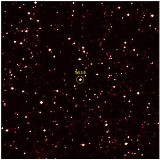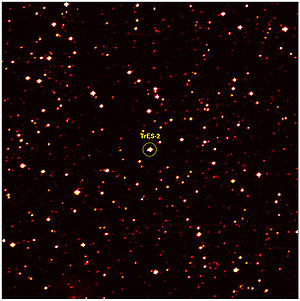
TrES-2
Encyclopedia
TrES-2b is an extrasolar planet
orbiting the star
GSC 03549-02811
located 718 light years away from our solar system. The planet has been identified in 2011 as the darkest known exoplanet, reflecting less than 1% of any light that hits it. The planet's mass and radius indicate that it is a gas giant
with a bulk composition similar to that of Jupiter
. Unlike Jupiter, but similar to many planets detected around other stars, TrES-2b is located very close to its star, and belongs to the class of planets known as hot Jupiter
s. This system is within the field of view
of the now operational Kepler spacecraft.
This planet continues to be studied by other projects and the parameters are being improved continuously. A 2007 study improved stellar and planetary parameters. A 2008 study concluded that the TrES-2 system is a binary star
system. This has a significant effect on the values for the stellar and the planetary parameters.
(TrES) by detecting the transit of the planet across its parent star using Sleuth (Palomar Observatory
, California
) and PSST (Lowell Observatory
, Arizona
), part of the TrES network of 10–cm telescopes. The discovery was confirmed by the W. M. Keck Observatory on September 8, 2006, by measuring the radial velocity of the star that hosts TrES-2b.

, measured in 2011. If the entire day-night contrast were due to geometric albedo, it would be 2.53%, but modeling suggests that much of this is dayside emission
and the true albedo is much lower. It is estimated to be less than 1% and for best-fit model it is about 0.04%. This makes TrES-2b the darkest known exoplanet, reflecting less light than coal or black acrylic paint. It is not clear why the planet is so dark. One reason could be an absence of reflective clouds such as those which make Jupiter so bright, due to TrES-2b's proximity to its parent star and the consequent high temperature. Another reason could be the presence in the atmosphere of light-absorbing chemicals such as vaporized sodium, potassium, or gaseous titanium oxide. In general, hot Jupiters are expected to be dark, because "absorption due to the broad wings of the sodium and potassium D lines is thought to dominate their visible spectra." Apart from that of Kepler-7b
, albedo measurements for hot Jupiters have generally given only upper limits.
Extrasolar planet
An extrasolar planet, or exoplanet, is a planet outside the Solar System. A total of such planets have been identified as of . It is now known that a substantial fraction of stars have planets, including perhaps half of all Sun-like stars...
orbiting the star
Star
A star is a massive, luminous sphere of plasma held together by gravity. At the end of its lifetime, a star can also contain a proportion of degenerate matter. The nearest star to Earth is the Sun, which is the source of most of the energy on Earth...
GSC 03549-02811
GSC 03549-02811
GSC 03549-02811 A is a yellow main-sequence star similar to our Sun. This star is located approximately 718 light-years away in the constellation of Draco. The apparent magnitude of this star is 11.41, which means it is not visible to the naked eye but can be seen with a medium-sized amateur...
located 718 light years away from our solar system. The planet has been identified in 2011 as the darkest known exoplanet, reflecting less than 1% of any light that hits it. The planet's mass and radius indicate that it is a gas giant
Gas giant
A gas giant is a large planet that is not primarily composed of rock or other solid matter. There are four gas giants in the Solar System: Jupiter, Saturn, Uranus, and Neptune...
with a bulk composition similar to that of Jupiter
Jupiter
Jupiter is the fifth planet from the Sun and the largest planet within the Solar System. It is a gas giant with mass one-thousandth that of the Sun but is two and a half times the mass of all the other planets in our Solar System combined. Jupiter is classified as a gas giant along with Saturn,...
. Unlike Jupiter, but similar to many planets detected around other stars, TrES-2b is located very close to its star, and belongs to the class of planets known as hot Jupiter
Hot Jupiter
Hot Jupiters are a class of extrasolar planet whose mass is close to or exceeds that of Jupiter...
s. This system is within the field of view
Field of view
The field of view is the extent of the observable world that is seen at any given moment....
of the now operational Kepler spacecraft.
This planet continues to be studied by other projects and the parameters are being improved continuously. A 2007 study improved stellar and planetary parameters. A 2008 study concluded that the TrES-2 system is a binary star
Binary star
A binary star is a star system consisting of two stars orbiting around their common center of mass. The brighter star is called the primary and the other is its companion star, comes, or secondary...
system. This has a significant effect on the values for the stellar and the planetary parameters.
Discovery
TrES-2b was discovered on August 21, 2006 by the Trans-Atlantic Exoplanet SurveyTrans-Atlantic Exoplanet Survey
The Trans-atlantic Exoplanet Survey or TrES, uses three 4-inch telescopes located at Lowell Observatory, Palomar Observatory, and the Canary Islands to locate exoplanets. It was made using the network of small, relatively inexpensive telescopes designed to look specifically for planets orbiting...
(TrES) by detecting the transit of the planet across its parent star using Sleuth (Palomar Observatory
Palomar Observatory
Palomar Observatory is a privately owned observatory located in San Diego County, California, southeast of Pasadena's Mount Wilson Observatory, in the Palomar Mountain Range. At approximately elevation, it is owned and operated by the California Institute of Technology...
, California
California
California is a state located on the West Coast of the United States. It is by far the most populous U.S. state, and the third-largest by land area...
) and PSST (Lowell Observatory
Lowell Observatory
Lowell Observatory is an astronomical observatory in Flagstaff, Arizona. Lowell Observatory was established in 1894, placing it among the oldest observatories in the United States, and was designated a National Historic Landmark in 1965....
, Arizona
Arizona
Arizona ; is a state located in the southwestern region of the United States. It is also part of the western United States and the mountain west. The capital and largest city is Phoenix...
), part of the TrES network of 10–cm telescopes. The discovery was confirmed by the W. M. Keck Observatory on September 8, 2006, by measuring the radial velocity of the star that hosts TrES-2b.
Spin-orbit angle
In August 2008 more details of the relationship between the parent star and the orbit of the planet were published. The orbit was determined to be tilted by − from the stellar equator. The orbital direction was determined to be in the same direction as the star's rotation (prograde).The Kepler mission
NASA launched Kepler in March 2009. The spacecraft is dedicated to the discovery of extrasolar planets by the transit method from solar orbit. In April 2009 the project released the first light images from the spacecraft, and TrES-2b was one of two objects highlighted in these images. Although TrES-2b is not the only known exoplanet in the field of view of this spacecraft it is the only one identified in the first light images. This object is important for calibration and check-out.
Darkest planet
The first important result from the Kepler Mission about TrES-2b is an extremely low geometric albedoGeometric albedo
The geometric albedo of an astronomical body is the ratio of its actual brightness at zero phase angle to that of an idealized flat, fully reflecting, diffusively scattering disk with the same cross-section....
, measured in 2011. If the entire day-night contrast were due to geometric albedo, it would be 2.53%, but modeling suggests that much of this is dayside emission
Black body
A black body is an idealized physical body that absorbs all incident electromagnetic radiation. Because of this perfect absorptivity at all wavelengths, a black body is also the best possible emitter of thermal radiation, which it radiates incandescently in a characteristic, continuous spectrum...
and the true albedo is much lower. It is estimated to be less than 1% and for best-fit model it is about 0.04%. This makes TrES-2b the darkest known exoplanet, reflecting less light than coal or black acrylic paint. It is not clear why the planet is so dark. One reason could be an absence of reflective clouds such as those which make Jupiter so bright, due to TrES-2b's proximity to its parent star and the consequent high temperature. Another reason could be the presence in the atmosphere of light-absorbing chemicals such as vaporized sodium, potassium, or gaseous titanium oxide. In general, hot Jupiters are expected to be dark, because "absorption due to the broad wings of the sodium and potassium D lines is thought to dominate their visible spectra." Apart from that of Kepler-7b
Kepler-7b
Kepler-7b is one of the first five planets to be confirmed by NASA's Kepler spacecraft, and was confirmed in the first 33.5 days of Kepler's science operations. It is in the orbit of a star that is not as hot as the Sun, but is significantly larger and is expected to soon reach the end of the main...
, albedo measurements for hot Jupiters have generally given only upper limits.

